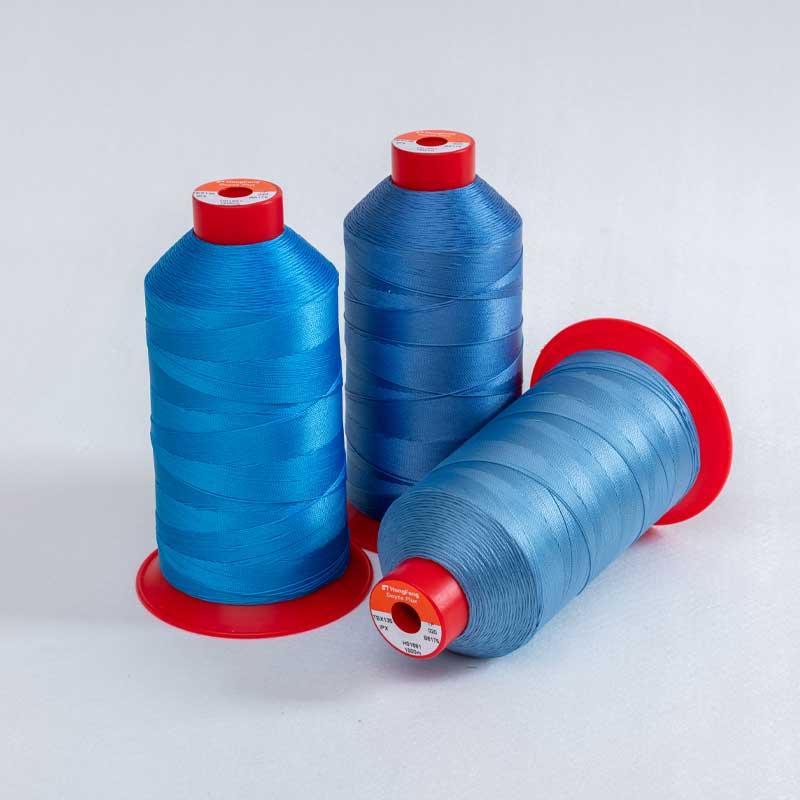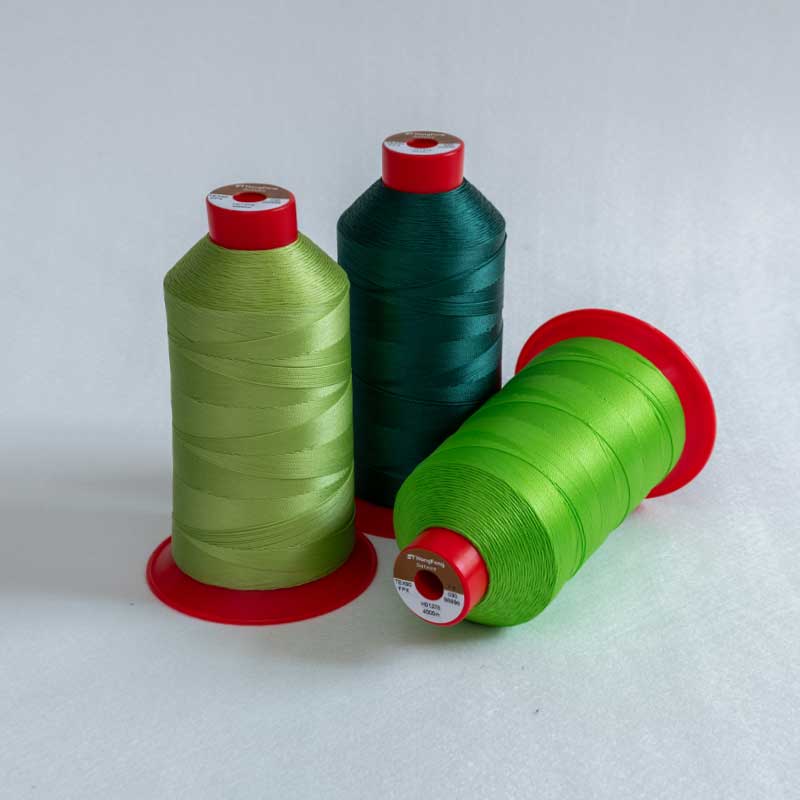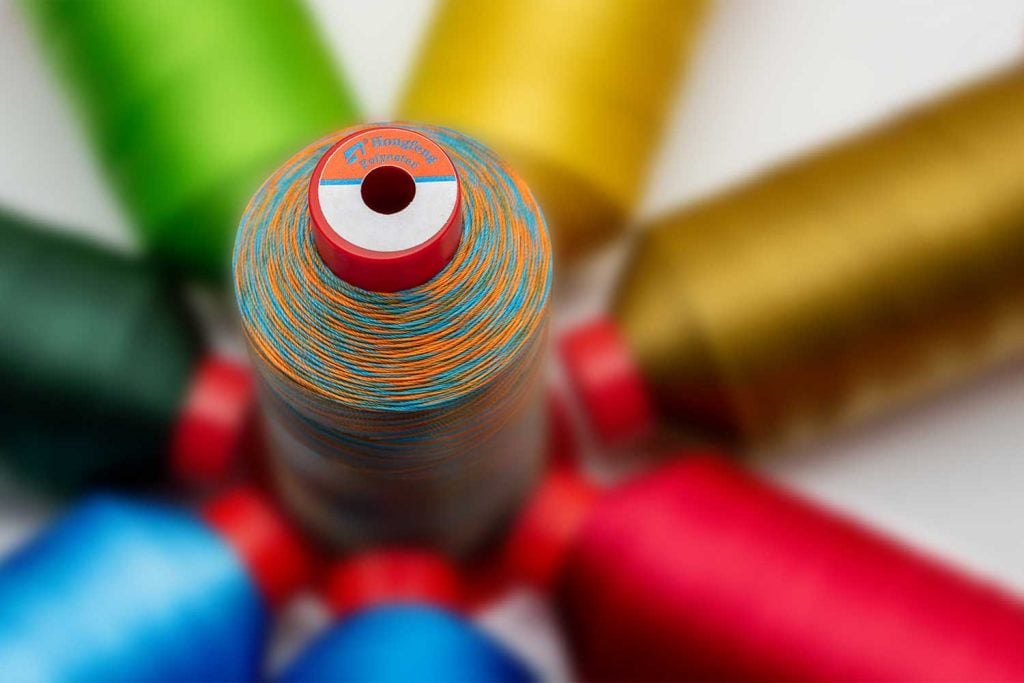Polyester & nylon threads manufacturers
heavy duty thread
high strength sewing thread
Expert in High Tenacity Filament Sewing Thread. High-quality Sewing Machine Thread for Any Size Job or Budget.
Hot Sale Heavy Duty Sewing Thread online.


Doyte®
Polyester Heavy Duty Sewing Thread
- Elegant luster Strong seam Beautiful stitches Strong chemical resistance
- Wide selection of OEKO-TEX 100 colours
- Professional lubricating oil, good seamability
- No loose shares, high production efficiency (Doyte®plus)
- High strength and good wear resistance
- Strong seam, beautiful stitches


Satees®
Nylon Heavy Duty Sewing Thread
- High strength and good wear resistance
- High color fastness, not easy to discolor
- Professional lubricating oil, good seamability
- No loose shares, high production efficiency ( Satees®plus)
- Good extensibility

Features of Heavy Duty Sewing Thread
Heavy Duty Sewing Thread has a certain tensile force, strong tensile force, luster, high temperature resistance, high speed, and is mainly suitable for leather sewing, such as: shoe industry, bag industry, sofa industry, etc. High-strength thread is the most common leather sewing thread.
Different from ordinary filament sewing thread, the raw material of high-strength sewing thread has special requirements. Generally, the required breaking strength of the raw material is greater than 7.0GD (such as polyester). Hongfeng Doyte series high strength poyester sewing thread uses the best raw materials to break Strength is greater than 8.0GD.

Heavy Duty Polyester Sewing Thread
Heavy Duty Polyester Sewing Thread made of CF polyester, has high strength, good elasticity, wear resistance, low shrinkage and good chemical stability. However, the melting point is low, and it is easy to melt at high speed, so attention should be paid to the selection of needles. Mainly used for denim, sportswear, leather products, wool and military uniforms, etc. It is the most used and popular high-strength sewing thread.

Heavy Duty Nylon Sewing Thread
Heavy Duty Nylon Sewing Thread made of pure CF nylon, divided into filament thread and elastic deformation thread. Commonly used is filament high-strength sewing thread, which has large elongation and good elasticity, and its tensile length at the moment of breaking is three times greater than that of cotton thread of the same specification. For the sewing of chemical fiber, woolen, leather and elastic garments.

How to Choose the Right Heavy Duty Sewing Thread
Under the specified conditions, the ability of high-strength sewing threads to form good stitches while maintaining certain mechanical properties, called sewability, is a comprehensive indicator for evaluating the quality of sewing threads. According to the material, thickness, structure, color, sewing style, sewing equipment or means of the sewing material, select sutures and needles with matching types and specifications. Generally, the following principles can be followed:
- The speed of your industrial sewing process
- Whether your sewing is unidirectional or multidirectional
- The importance of a perfect, flat seam
- How thick and tough the stitch needs to be
- How heavy the material is
- The amount of friction and abrasion the material causes
- We recommend that you learn as much as possible about the specs involved and how they relate to your application. Look at critical parameters such as denier (thread size), strength, and elongation at break.
Coordinate with fabric properties
It can ensure the uniformity of shrinkage rate, heat resistance, abrasion resistance, durability, etc., and avoid shrinkage caused by excessive differences between threads and fabrics. Generally, soft and thin materials use thin threads with small needles, and hard and thick materials use thick threads and large needles.
Coordinate with sewing equipment
The lockstitch machine uses left-handed stitches, which can be twisted during sewing to maintain the strength of the stitches.

Coordinate with stitch form
The bag (stretch) sewing machine uses fine cotton thread, the sewing material is not easy to deform and wrinkle, and the chain stitch is beautiful and comfortable. Double stitches should use sutures with good extensibility. The crotch seam and shoulder seam should use firm stitching. Buttonhole stitches should be durable stitches.
Coordinate with the type of clothing
Special-purpose clothing, such as elastic clothing, needs to use elastic nylon thread, and fire-fighting clothing should use high-strength threads with heat-resistant, flame-retardant and waterproof treatment.


Heavy Duty Sewing Thread: Bonded Thread VS Non-bonded
Non-bonded CF Thread
Non-bonded high strength sewing threads and yarns are minimally processed. These products are often labeled as soft threads due to their appearance. Although these soft threads don’t go through a coating process, they’re usually conditioned and heat-set before final winding to prevent the individual ends from opening up when cut.
Soft, non-bonded high strength sewing thread and yarn are most suited for slower processing speeds where multi-directional sewing is not required. When your manufacturing involves long unidirectional sewing patterns, adequately lubricated non-bonded filament thread and yarn may be processed at high speeds. In many instances, soft filament sewing thread can also be used as a bottom thread.
A non-bonded high strength sewing thread has the advantage of being widely available at a lower cost than bonded filament thread and may work well in sewing processes where you need a large quantity of reasonably-priced thread without the demands of high tension, high speed, or abrasive/thick materials.

CF Bonded Thread
If high-speed multi-directional sewing is part of your process, use bonded high strength sewing thread to prevent snags and cuts. Bonded filament thread has a resin coating that prevents the plies of the thread from opening up in the reverse direction and becoming clumped together.
The bonded coating of this type of high strength sewing thread creates a smooth, even finish that keeps the ends together with more cohesion and resists friction and abrasion. This means your industrial sewing process can take place at very high speeds, even with multi-directional sewing. An additional benefit of bonded sewing thread is fray resistance for cut ends and slightly stiffer yarn that is much easier to handle for threading and needle applications.

Top 7 Benefits of High Strength Sewing Thread
High strength sewing thread offers several benefits due to its exceptional strength and durability. Here are some advantages of using high strength sewing thread:
Enhanced Durability
High strength sewing thread is designed to withstand heavy loads, tension, and abrasion. It provides superior durability compared to regular sewing thread, ensuring that the stitches can endure stress and maintain their integrity over time. This makes it ideal for applications where long-lasting and reliable stitching is crucial.
Increased Seam Strength
The use of high strength sewing thread results in stronger seams. Whether sewing heavy fabrics, leather, vinyl, or other challenging materials, the thread’s superior strength ensures that the seams can handle the demands placed on them. This is particularly important in industries such as automotive, upholstery, and outdoor gear, where the stitched components need to withstand constant use and potential wear.
Resistance to Breaking and Fraying
High strength sewing thread is less prone to breaking or fraying under tension. This is particularly advantageous in applications where the thread is subjected to high stress or repetitive motions, such as in industrial sewing or heavy-duty use. It helps minimize the risk of seam failures and the need for frequent repairs.
Excellent Abrasion Resistance
High strength sewing thread is designed to resist abrasion and wear. It can withstand friction and rubbing without deteriorating or wearing down easily. This characteristic is valuable in applications where the thread is exposed to rough surfaces or constant movement, such as in upholstery, outdoor gear, and footwear manufacturing.
Versatility in Material Compatibility
High strength sewing thread is suitable for stitching a wide range of materials, including heavy fabrics, leather, vinyl, and synthetic textiles. Its exceptional strength allows it to adapt to various material types and thicknesses, making it a versatile choice for different sewing projects.
Reliable Performance in Challenging Conditions
High strength sewing thread performs well in demanding conditions, including exposure to extreme temperatures, UV rays, moisture, and chemicals. It can withstand these environmental factors without significantly degrading or losing its strength, ensuring the longevity and integrity of the stitched seams.
Wide Range of Applications
High strength sewing thread finds applications in diverse industries such as automotive, upholstery, outdoor gear, footwear, and heavy-duty sewing. Its strength and durability make it suitable for stitching upholstery, seat covers, safety equipment, heavy-duty bags, footwear, and other products that require robust and long-lasting seams.

Top 8 Applications of High Strength Sewing Thread
Bonded heavy duty sewing thread and industrial yarns are a great fit for heavy industrial applications like the manufacture of geotextiles, synthetic web slings, heavy tarps, canvas, and automotive upholstery.
Increasingly, bonded filament threads are used to replace soft yarns in the critical industrial manufacturing of fiber optic cables and wires as ripcords, binders, or strength members. Other uses include heavy stitching applications that require light product weight overall, like automotive airbags, lifting slings, tie-downs, rock climbing gear, sporting equipment, and parachutes.
Automotive Industry
High strength sewing thread is widely used in automotive manufacturing for stitching upholstery, seat covers, steering wheel covers, and other interior components. The thread’s strength ensures that the stitches can withstand the stress and wear associated with automotive use.
Upholstery and Furniture
In upholstery and furniture manufacturing, high strength sewing thread is crucial for stitching heavy fabrics, leather, and vinyl. It provides the necessary strength to secure seams and prevent unraveling, ensuring the longevity of the furniture.
Outdoor Gear and Apparel
High strength sewing thread is commonly used in the production of outdoor gear and apparel such as tents, backpacks, sleeping bags, and jackets. The thread’s strength allows it to withstand the rigors of outdoor use, including exposure to harsh weather conditions, abrasion, and tension.
Marine and Sailmaking
In the marine industry, high strength sewing thread is used for stitching sails, boat covers, awnings, and other marine applications. The thread’s strength and resistance to UV rays and saltwater ensure that the stitches remain intact and durable in marine environments.
Footwear Manufacturing
High strength sewing thread is vital in footwear manufacturing, where it is used for stitching shoe uppers, soles, and other components. The thread’s strength ensures the integrity of the stitches, providing long-lasting and durable footwear products.
Heavy-duty Bags and Luggage
High strength sewing thread is utilized in the production of heavy-duty bags, backpacks, and luggage items. It can withstand the weight-bearing requirements and stress associated with these products, ensuring that the seams remain intact under heavy loads.
Leather Goods
High strength sewing thread is commonly used in the production of leather goods such as wallets, handbags, belts, and leather accessories. The thread’s strength and durability are necessary to handle the demands of working with thick and dense leather materials.
Industrial and Safety Equipment
High strength sewing thread is employed in the manufacturing of industrial and safety equipment, including harnesses, safety belts, and protective gear. The thread’s strength is crucial for ensuring the safety and reliability of these products in high-risk environments.

High Strength Sewing Thread Size Descriptions
Size 15
Size 15 (Tex 16) high strength sewing thread is an ultra lightweight thread used on home and commercial machines with a size 70/10 to 80/12 needle. Its stitch appearance is inconspicuous.
Tex 16 Nylon Tex 16 Polyester
Size 33
Size 33 (Tex 30) high strength sewing thread is a lightweight thread used on home and commercial machines with a size 80/12 to 90/14 needle. Its stitch appearance is inconspicuous.
Tex 30 Nylon Tex 30 Polyester
Size 46
Size 46 (Tex 45) high strength sewing thread is a lightweight thread used on home and commercial machines with a size 90/14 to 100/16 needle. Its stitch appearance is inconspicuous.
Tex 45 Nylon Tex 45 Polyester
Size 69
Size 69 (Tex 70) filament thread is a middleweight thread used on home and commercial machines with a size 100/16 to 110 /18 needle. Its stitch appearance is inconspicuous, becoming more noticeable.
Tex 70 Nylon Tex 70 Polyester
Size 92
Size 92 (Tex 90) filament sewing thread is a middleweight thread used on commercial machines with a size 110/18 to 125/20 needle. Its stitch appearance is noticeable.
Tex 90 Nylon Tex 90 Polyester
Size 138
Size 138 (Tex 135) is a middle to heavyweight thread used on commercial and heavy duty machines with a size 125/20 to 140/22 needle. Its stitch appearance is noticeable, beginning to stand out.
Tex 135 Nylon Tex 135 Polyester
Size 207
Size 207 (Tex 210) filament thread is a heavyweight thread used on commercial and heavy duty machines with a size 140/22 to 180/24 needle. Its stitch appearance stands out.
Tex 210 Nylon Tex 210 Polyester
Size 277
Size 277 (Tex 270) high strength sewing thread is a heavyweight thread used on commercial and heavy duty machines with a size 180/24 to 220/26 needle. Its stitch appearance stands out, becoming more of a focal point.
Tex 270 Nylon Tex 270 Polyester
Size 346
Size 346 (Tex 350) filament sewing thread is a heavyweight thread used on heavy duty machines with a size 220/26 to 260/28 needle. Its stitch appearance is a focal point.
Tex 350 Nylon Tex 350 Polyester
Size 415
Size 410 (Tex 400) fliament thread is a heavyweight thread used on heavy duty machines with a size 260/28 to 330/30 needle. Its stitch appearance is a focal point. It is available in black and white.
Tex 400 Nylon Tex 410 Polyester
Size 554
Size 554 (Tex 600) filament sewing thread is an ultra heavyweight thread used on heavy duty machines with a size 330/30 to 360/32 needle. Its stitch appearance is a focal point. It is about 1 mm thick.
